Three-Dimensional Structural Modeling (3D SM) and Joint Geophysical Characterization (JGC) of Hydrocarbon Reservoir
Abstract
:1. Introduction
2. Background Geology
3. Material and Methods
3.1. Datasets Description and Processing
3.2. Methods
3.2.1. Seismic Data Interpretation
3.2.2. Three-Dimensional Structural Modeling (3D SM)
3.2.3. Three-Dimensional Seismic Attribute Analysis
3.2.4. Petrophysical Modeling
- (1)
- Volume of Shale (Vshale)—The presence of shale in the productive zone severely impacts the petrophysical properties and can cause a reduction in the ∅eff, ∅avg, and permeability [58]. We used the GR log technique for Vshale estimation by firstly estimating the gamma ray index (IGR). The IGR was initially adopted using Equation (1) to estimate Vshale, utilizing the GRlog in track 1 of Figure 6. Secondly, to obtain a realistic Vshale estimation without overestimating the content of shale (first-order approximation: Vshale = IGR), a non-linear relationship (Equation (2)) proposed by Dolan was employed [59].where IGR stands for gamma ray index, GRlog shows the reading of the gamma ray log, GRmin and GRmax are the lower and upper limits of the GRlog value in shale, respectively.
- (2)
- Average Porosity (∅avg)—Total porosity or ∅avg represents all the voids or pore spaces of the rock, including interconnected and isolated pores and pore spaces occupied by clay-bound water [2]. In this study, DT, RHOB, and NPHI logs that are sensitive to sedimentary micro-facies were selected to calculate ∅avg, by which process the conventional logging responses of the G and E sand reservoir intervals can be summarized (Figure 6).The DT log measures the sound waves’ traveling times in the rock unit. The sound waves in the rock unit depend on the shape, matrix material, and cementation (Equation (3)). Accordingly, the Sonic–Raymer (SR) porosity model was used to evaluate sonic porosity (∅S) (Equation (4)) [40].where ∅S represents sonic porosity, tlog represents the log reading in μsec/m, tm represents the matrix interval transient time, ∆tlog represents the formation interval transient time in μsec/m, and ∆tm represents formation fluids’ interval transient time in μsec/m.The density porosity (ϕD) was calculated using the RHOB log via Equation (5) [2].where represents the density of the matrix, represents the fluid density, and is the bulk density.The NPHI log measures the neutron porosity (∅N) by assuming that the pores are filled with fluid. Therefore, it measures the hydrogen concentration and energy loss. The ∅N can be expressed via Equation (6).where is the neutron-derived porosity, a and b are constants, and N is the neutron count in the formation intervals. In addition, the density–neutron cross-plot in track 4 in Figure 6 determines the cross-over gas effects.After identifying the porosities (e.g., ∅S, ∅D, and ∅N) from the DT, RHOB, and NPHI logs, Equation (7) was used to calculate ∅avg.
- (3)
- (4)
- Water Saturation (SW)—The Poupon–Leveaux Indonesian (PLI) model is one of the best models for estimating SW in a shaly sand reservoir [60]. In this study, the constraints of Vshale (Equation (2)) and ∅eff (Equation (8)), and the resistivity variation in Vshale and water formation, were subsequently integrated using the PLI model, as in Equation (9), to determine SW.where is the true resistivity of the formation obtained from the LLD log response, is the resistivity variation in the , and is the resistivity of water formation.
- (5)
- Hydrocarbon Saturation (Shc)—The Shc was calculated by subtracting the percentage of pore volume occupied by Sw from 1; the remaining percentage pore volume gives the Shc (Equation (10)).
4. Results
4.1. Stratigraphic Interfaces Interpretation
4.2. Three-Dimensional Fault System Models (3D FSMs)
4.3. Three-Dimensional Structural Models (3D SMs)
4.4. Seismic Attributes Interpretation
4.4.1. Variance Edge Attribute
4.4.2. Sweetness Attribute
4.4.3. RMS Amplitude Attribute
4.5. Petrophysical Modeling
5. Discussion
5.1. Integration of 3D SM and JGC for Hydrocarbon Evaluation
5.2. Analysis of Gas Reserve of the Kadanwari Field
5.3. Comparative Analysis with Other Reservoirs
6. Conclusions
- (1)
- The 3D structural interpretation illustrates the complex structural mechanics, controlled by the NW–SE dipping normal faults system, operating in the early Cretaceous stratigraphic sequence. The identified features include horsts, half-graben, and graben structures. The spatial distribution of the fault system shows that the overall pattern of the interpreted fault system can be regarded as a negative flower structure. The negative flower structure incorporates the combined effects of extensional and strike-slip motion in the study area. In general, the horsts, half-graben, and graben, along with the faults, have geometrically determined reservoir (G and E sand intervals) geomorphology, up-dip hydrocarbon migration, the development of the local strata, the distribution of facies and properties, and internal structural deformation;
- (2)
- The variance edge attribute enhanced the geometric distribution of the faults within the seismic data. The sweetness attribute distinguished the sand facies from shale, as the increased amplitude and lower frequency content represent cleaner and more payable sand zones. In contrast, areas with low amplitude and high-frequency anomalies are susceptible to shale. The RMS amplitude and sweetness attribute results indicate the hydrocarbon zones. Relatively high RMS amplitude attribute values are usually connected with lithological changes, sand-rich shoreward facies, bright spots, and especially gas-saturated sand zones. In comparison, low amplitudes anomalies indicate the zones of sandy-shale, shale, and pro-delta facies;
- (3)
- Petrophysical modeling reveals the important parameters of G and E sand reservoir intervals. The ∅avg values calculated via the Sonic–Raymer (SR) porosity model, the RHOB log, and the NPHI log show that the G and E sand reservoir intervals have good porosities. Moreover, the E sand interval has good ∅eff and Shc and displays clear signs of gas effects verified by the cross-overs of density and neutron log curves. Therefore, it can be considered an economically viable reservoir interval for future hydrocarbon production.
Author Contributions
Funding
Data Availability Statement
Acknowledgments
Conflicts of Interest
References
- Qadri, S.T.; Islam, M.A.; Shalaby, M.R.; Ali, S.H. Integration of 1D and 3D modeling schemes to establish the Farewell Formation as a self-sourced reservoir in Kupe Field, Taranaki Basin, New Zealand. Front. Earth Sci. 2020, 15, 631–648. [Google Scholar] [CrossRef]
- Thota, S.T.; Islam, M.A.; Shalaby, M.R. A 3D geological model of a structurally complex relationships of sedimentary Facies and Petrophysical Parameters for the late Miocene Mount Messenger Formation in the Kaimiro-Ngatoro field, Taranaki Basin, New Zealand. J. Pet. Explor. Prod. Technol. 2021, 11, 1–36. [Google Scholar] [CrossRef]
- Masters, C.D.; Root, D.H.; Attanasi, E.D.; Tedeschi, M.; Singh, S.; du Plessis, M.; Wong, S.; Redford, D.; Wightman, D.; MacGillivray, J. World resources of crude oil and natural gas. Energy Explor. Exploit. 1991, 9, 354–374. [Google Scholar]
- Mangi, H.N.; Chi, R.; DeTian, Y.; Sindhu, L.; He, D.; Ashraf, U.; Fu, H.; Zixuan, L.; Zhou, W.; Anees, A. The ungrind and grinded effects on the pore geometry and adsorption mechanism of the coal particles. J. Nat. Gas Sci. Eng. 2022, 100, 104463. [Google Scholar] [CrossRef]
- Mangi, H.N.; Detian, Y.; Hameed, N.; Ashraf, U.; Rajper, R.H. Pore structure characteristics and fractal dimension analysis of low rank coal in the Lower Indus Basin, SE Pakistan. J. Nat. Gas Sci. Eng. 2020, 77, 103231. [Google Scholar] [CrossRef]
- Sheikh, N.; Giao, P.H. Evaluation of shale gas potential in the lower cretaceous Sembar formation, the southern Indus basin, Pakistan. J. Nat. Gas Sci. Eng. 2017, 44, 162–176. [Google Scholar] [CrossRef]
- Saif-Ur-Rehman, K.J.; Lin, D.; Ehsan, S.A.; Jadoon, I.A.; Idrees, M. Structural styles, hydrocarbon prospects, and potential of Miano and Kadanwari fields, Central Indus Basin, Pakistan. Arab. J. Geosci. 2020, 13, 97. [Google Scholar]
- Ahmad, N.; Khan, S.; Al-Shuhail, A. Seismic Data Interpretation and Petrophysical Analysis of Kabirwala Area Tola (01) Well, Central Indus Basin, Pakistan. Appl. Sci. 2021, 11, 2911. [Google Scholar] [CrossRef]
- Khan, U.; Zhang, B.; Du, J.; Jiang, Z. 3D structural modeling integrated with seismic attribute and petrophysical evaluation for hydrocarbon prospecting at the Dhulian Oilfield, Pakistan. Front. Earth Sci. 2021, 15, 649–675. [Google Scholar] [CrossRef]
- Bodunde, S.; Enikanselu, P. Integration of 3D-seismic and petrophysical analysis with rock physics analysis in the characterization of SOKAB field, Niger delta, Nigeria. J. Pet. Explor. Prod. Technol. 2019, 9, 899–909. [Google Scholar] [CrossRef] [Green Version]
- Hossain, M.I.S.; Woobaidullah, A.; Rahman, M.J. Reservoir characterization and identification of new prospect in Srikail gas field using wireline and seismic data. J. Pet. Explor. Prod. Technol. 2021, 11, 2481–2495. [Google Scholar] [CrossRef]
- Kargarpour, M.A. Carbonate reservoir characterization: An integrated approach. J. Pet. Explor. Prod. Technol. 2020, 10, 2655–2667. [Google Scholar] [CrossRef]
- Islam, M.A.; Yunsi, M.; Qadri, S.T.; Shalaby, M.R.; Haque, A.E. Three-dimensional structural and petrophysical modeling for reservoir characterization of the Mangahewa formation, Pohokura Gas-Condensate Field, Taranaki Basin, New Zealand. Nat. Resour. Res. 2021, 30, 371–394. [Google Scholar] [CrossRef]
- Li, X.; Zhou, N.; Xie, X. Reservoir characteristics and three-dimensional architectural structure of a complex fault-block reservoir, beach area, China. J. Pet. Explor. Prod. Technol. 2018, 8, 1535–1545. [Google Scholar] [CrossRef] [Green Version]
- Osinowo, O.O.; Ayorinde, J.O.; Nwankwo, C.P.; Ekeng, O.; Taiwo, O. Reservoir description and characterization of Eni field Offshore Niger Delta, southern Nigeria. J. Pet. Explor. Prod. Technol. 2018, 8, 381–397. [Google Scholar] [CrossRef] [Green Version]
- Haque, A.E.; Islam, M.A.; Shalaby, M.R. Structural modeling of the Maui gas field, Taranaki basin, New Zealand. Pet. Explor. Dev. 2016, 43, 965–975. [Google Scholar] [CrossRef]
- Mutebi, S.; Sen, S.; Sserubiri, T.; Rudra, A.; Ganguli, S.S.; Radwan, A.E. Geological characterization of the Miocene–Pliocene succession in the Semliki Basin, Uganda: Implications for hydrocarbon exploration and drilling in the East African Rift System. Nat. Resour. Res. 2021, 30, 4329–4354. [Google Scholar] [CrossRef]
- Abdeen, M.M.; Ramadan, F.S.; Nabawy, B.S.; El Saadawy, O. Subsurface Structural Setting and Hydrocarbon Potentiality of the Komombo and Nuqra Basins, South Egypt: A Seismic and Petrophysical Integrated Study. Nat. Resour. Res. 2021, 30, 3575–3603. [Google Scholar] [CrossRef]
- Ashraf, U.; Zhu, P.; Yasin, Q.; Anees, A.; Imraz, M.; Mangi, H.N.; Shakeel, S. Classification of reservoir facies using well log and 3D seismic attributes for prospect evaluation and field development: A case study of Sawan gas field, Pakistan. J. Pet. Sci. Eng. 2019, 175, 338–351. [Google Scholar] [CrossRef]
- Hussain, M.; Ahmed, N.; Chun, W.Y.; Khalid, P.; Mahmood, A.; Ahmad, S.R.; Rasool, U. Reservoir characterization of basal sand zone of lower Goru Formation by petrophysical studies of geophysical logs. J. Geol. Soc. India 2017, 89, 331–338. [Google Scholar] [CrossRef]
- Moore, G.F. 3-D seismic interpretation. Am. Geophys. Union 2009, 90, 161. [Google Scholar] [CrossRef] [Green Version]
- Vo Thanh, H.; Sugai, Y.; Sasaki, K. Impact of a new geological modelling method on the enhancement of the CO2 storage assessment of E sequence of Nam Vang field, offshore Vietnam. Energy Sources Part A Recovery Util. Environ. Eff. 2020, 42, 1499–1512. [Google Scholar] [CrossRef]
- Houlding, S. 3D Geoscience Modeling: Computer Techniques for Geological Characterization; Springer Science & Business Media: Berlin/Heidelberg, Germany, 2012. [Google Scholar]
- Lajaunie, C.; Courrioux, G.; Manuel, L. Foliation fields and 3D cartography in geology: Principles of a method based on potential interpolation. Math. Geol. 1997, 29, 571–584. [Google Scholar] [CrossRef]
- Mallet, J.-L. Geomodeling; Oxford University Press: Oxford, UK, 2002. [Google Scholar]
- Wu, Q.; Xu, H.; Zou, X. An effective method for 3D geological modeling with multi-source data integration. Comput. Geosci. 2005, 31, 35–43. [Google Scholar] [CrossRef]
- Zhang, B.; Chen, Y.; Huang, A.; Lu, H.; Cheng, Q. Geochemical field and its roles on the 3D prediction fo concealed ore-bodies. Acta Petrol. Sin. 2018, 34, 352–362. [Google Scholar]
- Wang, L.; Wu, X.; Zhang, B.; Li, X.; Huang, A.; Meng, F.; Dai, P. Recognition of significant surface soil geochemical anomalies via weighted 3D shortest-distance field of subsurface orebodies: A case study in the Hongtoushan copper mine, NE China. Nat. Resour. Res. 2019, 28, 587–607. [Google Scholar] [CrossRef]
- Thanh, H.V.; Sugai, Y.; Nguele, R.; Sasaki, K. Integrated workflow in 3D geological model construction for evaluation of CO2 storage capacity of a fractured basement reservoir in Cuu Long Basin, Vietnam. Int. J. Greenh. Gas Control 2019, 90, 102826. [Google Scholar] [CrossRef]
- Adelu, A.O.; Aderemi, A.; Akanji, A.O.; Sanuade, O.A.; Kaka, S.I.; Afolabi, O.; Olugbemiga, S.; Oke, R. Application of 3D static modeling for optimal reservoir characterization. J. Afr. Earth Sci. 2019, 152, 184–196. [Google Scholar] [CrossRef]
- Ayodele, O.L.; Chatterjee, T.; Opuwari, M. Static reservoir modeling using stochastic method: A case study of the cretaceous sequence of Gamtoos Basin, Offshore, South Africa. J. Pet. Explor. Prod. Technol. 2021, 11, 4185–4200. [Google Scholar] [CrossRef]
- Jung, A.; Aigner, T.; Palermo, D.; Nardon, S.; Pontiggia, M. A Hierarchical Database on Carbonate Geobodies and Its Application to Reservoir Modelling Using Multi-Point Statistics. In Proceedings of the 72nd EAGE Conference and Exhibition Incorporating SPE EUROPEC 2010, Barcelona, Spain, 14–17 June 2010; p. cp-161-00314. [Google Scholar]
- Li, J.; Zhang, X.; Lu, B.; Ahmed, R.; Zhang, Q. Static Geological Modelling with Knowledge Driven Methodology. Energies 2019, 12, 3802. [Google Scholar] [CrossRef] [Green Version]
- Okoli, A.E.; Agbasi, O.E.; Lashin, A.A.; Sen, S. Static Reservoir Modeling of the Eocene Clastic Reservoirs in the Q-Field, Niger Delta, Nigeria. Nat. Resour. Res. 2021, 30, 1411–1425. [Google Scholar] [CrossRef]
- Thanh, H.V.; Sugai, Y. Integrated modelling framework for enhancement history matching in fluvial channel sandstone reservoirs. Upstream Oil Gas Technol. 2021, 6, 100027. [Google Scholar] [CrossRef]
- Vo Thanh, H.; Lee, K.-K. 3D geo-cellular modeling for Oligocene reservoirs: A marginal field in offshore Vietnam. J. Pet. Explor. Prod. Technol. 2022, 12, 1–19. [Google Scholar] [CrossRef]
- Ali, M.; Abdelhady, A.; Abdelmaksoud, A.; Darwish, M.; Essa, M.A. 3D static modeling and petrographic aspects of the Albian/Cenomanian Reservoir, Komombo Basin, Upper Egypt. Nat. Resour. Res. 2020, 29, 1259–1281. [Google Scholar] [CrossRef]
- Azeem, T.; Yanchun, W.; Khalid, P.; Xueqing, L.; Yuan, F.; Lifang, C. An application of seismic attributes analysis for mapping of gas bearing sand zones in the sawan gas field, Pakistan. Acta Geod. Geophys. 2016, 51, 723–744. [Google Scholar] [CrossRef]
- Naseer, M.T. Seismic attributes and quantitative stratigraphic simulation’application for imaging the thin-bedded incised valley stratigraphic traps of Cretaceous sedimentary fairway, Pakistan. Mar. Pet. Geol. 2021, 134, 105336. [Google Scholar] [CrossRef]
- Ali, M.; Khan, M.J.; Ali, M.; Iftikhar, S. Petrophysical analysis of well logs for reservoir evaluation: A case study of “Kadanwari” gas field, middle Indus basin, Pakistan. Arab. J. Geosci. 2019, 12, 1–12. [Google Scholar] [CrossRef]
- Raza, M.; Khan, F.; Khan, M.; Riaz, M.; Khan, U. Reservoir characterization of the B-interval of lower goru formation, miano 9 and 10, miano area, Lower Indus Basin, Pakistan. Env. Earth Sci. Res. J. 2020, 7, 18–32. [Google Scholar] [CrossRef]
- Ahmad, N.; Spadini, G.; Palekar, A.; Subhani, M.A. Porosity prediction using 3D seismic inversion Kadanwari gas field, Pakistan. Pak. J. Hydrocarb. Res. 2007, 17, 95–102. [Google Scholar]
- Khan, M.J.; Khan, H.A. Petrophysical logs contribute in appraising productive sands of Lower Goru Formation, Kadanwari concession, Pakistan. J. Pet. Explor. Prod. Technol. 2018, 8, 1089–1098. [Google Scholar] [CrossRef] [Green Version]
- Dar, Q.U.; Pu, R.; Baiyegunhi, C.; Shabeer, G.; Ali, R.I.; Ashraf, U.; Sajid, Z.; Mehmood, M. The impact of diagenesis on the reservoir quality of the early Cretaceous Lower Goru sandstones in the Lower Indus Basin, Pakistan. J. Pet. Explor. Prod. Technol. 2021, 11, 1–16. [Google Scholar] [CrossRef]
- Ahmad, N.; Chaudhry, S. Kadanwari Gas Field, Pakistan: A disappointment turns into an attractive development opportunity. Pet. Geosci. 2002, 8, 307–316. [Google Scholar] [CrossRef]
- Kazmi, A.; Jan, M. Geology and Tectonics of Pakistan; Graphic Publishers: Santa Ana, CA, USA, 1997; p. 554. ISBN 9698375007. [Google Scholar]
- Saif-Ur-Rehman, K.J.; Mehmood, M.F.; Shafiq, Z.; Jadoon, I.A. Structural styles and petroleum potential of Miano block, central Indus Basin, Pakistan. Int. J. Geosci. 2016, 7, 1145. [Google Scholar]
- Ahmad, N.; Fink, P.; Sturrock, S.; Mahmood, T.; Ibrahim, M. Sequence stratigraphy as predictive tool in lower goru fairway, lower and middle Indus platform, Pakistan. PAPG ATC 2004, 1, 85–104. [Google Scholar]
- Ahmed, W.; Azeem, A.; Abid, M.F.; Rasheed, A.; Aziz, K. Mesozoic Structural Architecture of the Middle Indus Basin, Pakistan—Controls and Implications. In Proceedings of the PAPG/SPE Annual Technical Conference, Islamabad, Pakistan, 26 November 2013; pp. 1–13. [Google Scholar]
- Shakir, U.; Ali, A.; Hussain, M.; Azeem, T.; Bashir, L. Selection of Sensitive Post-Stack and Pre-Stack Seismic Inversion Attributes for Improved Characterization of Thin Gas-Bearing Sands. Pure Appl. Geophys. 2021, 179, 169–196. [Google Scholar] [CrossRef]
- Faleide, T.S.; Braathen, A.; Lecomte, I.; Mulrooney, M.J.; Midtkandal, I.; Bugge, A.J.; Planke, S. Impacts of seismic resolution on fault interpretation: Insights from seismic modelling. Tectonophysics 2021, 816, 229008. [Google Scholar] [CrossRef]
- Kim, M.; Yu, J.; Kang, N.-K.; Kim, B.-Y. Improved Workflow for Fault Detection and Extraction Using Seismic Attributes and Orientation Clustering. Appl. Sci. 2021, 11, 8734. [Google Scholar] [CrossRef]
- Khan, M.; Abdelmaksoud, A. Unfolding impacts of freaky tectonics on sedimentary sequences along passive margins: Pioneer findings from western Indian continental margin (Offshore Indus Basin). Mar. Pet. Geol. 2020, 119, 104499. [Google Scholar] [CrossRef]
- Qadri, S.T.; Islam, M.A.; Shalaby, M.R. Three-dimensional petrophysical modelling and volumetric analysis to model the reservoir potential of the Kupe Field, Taranaki Basin, New Zealand. Nat. Resour. Res. 2019, 28, 369–392. [Google Scholar] [CrossRef]
- Taner, M.T.; Koehler, F.; Sheriff, R. Complex seismic trace analysis. Geophysics 1979, 44, 1041–1063. [Google Scholar] [CrossRef]
- Ahmad, M.N.; Rowell, P. Application of spectral decomposition and seismic attributes to understand the structure and distribution of sand reservoirs within Tertiary rift basins of the Gulf of Thailand. Lead. Edge 2012, 31, 630–634. [Google Scholar] [CrossRef]
- Abuamarah, B.A.; Nabawy, B.S.; Shehata, A.M.; Kassem, O.M.; Ghrefat, H. Integrated geological and petrophysical characterization of oligocene deep marine unconventional poor to tight sandstone gas reservoir. Mar. Pet. Geol. 2019, 109, 868–885. [Google Scholar] [CrossRef]
- Iqbal, M.A.; Rezaee, R. Porosity and Water Saturation Estimation for Shale Reservoirs: An Example from Goldwyer Formation Shale, Canning Basin, Western Australia. Energies 2020, 13, 6294. [Google Scholar] [CrossRef]
- Dolan, P. Pakistan: A history of petroleum exploration and future potential. Geol. Soc. Lond. Spec. Publ. 1990, 50, 503–524. [Google Scholar] [CrossRef]
- Sam-Marcus, J.; Enaworu, E.; Rotimi, O.J.; Seteyeobot, I. A proposed solution to the determination of water saturation: Using a modelled equation. J. Pet. Explor. Prod. Technol. 2018, 8, 1009–1015. [Google Scholar] [CrossRef] [Green Version]
- Cuong, T.X.; Warren, J. Bach ho field, a fractured granitic basement reservoir, Cuu Long Basin, offshore SE Vietnam: A “buried-hill” play. J. Pet. Geol. 2009, 32, 129–156. [Google Scholar] [CrossRef]
- Kularathna, E.; Pitawala, H.; Senaratne, A.; Ratnayake, A. Play distribution and the hydrocarbon potential of the Mannar Basin, Sri Lanka. J. Pet. Explor. Prod. Technol. 2020, 10, 2225–2243. [Google Scholar] [CrossRef]
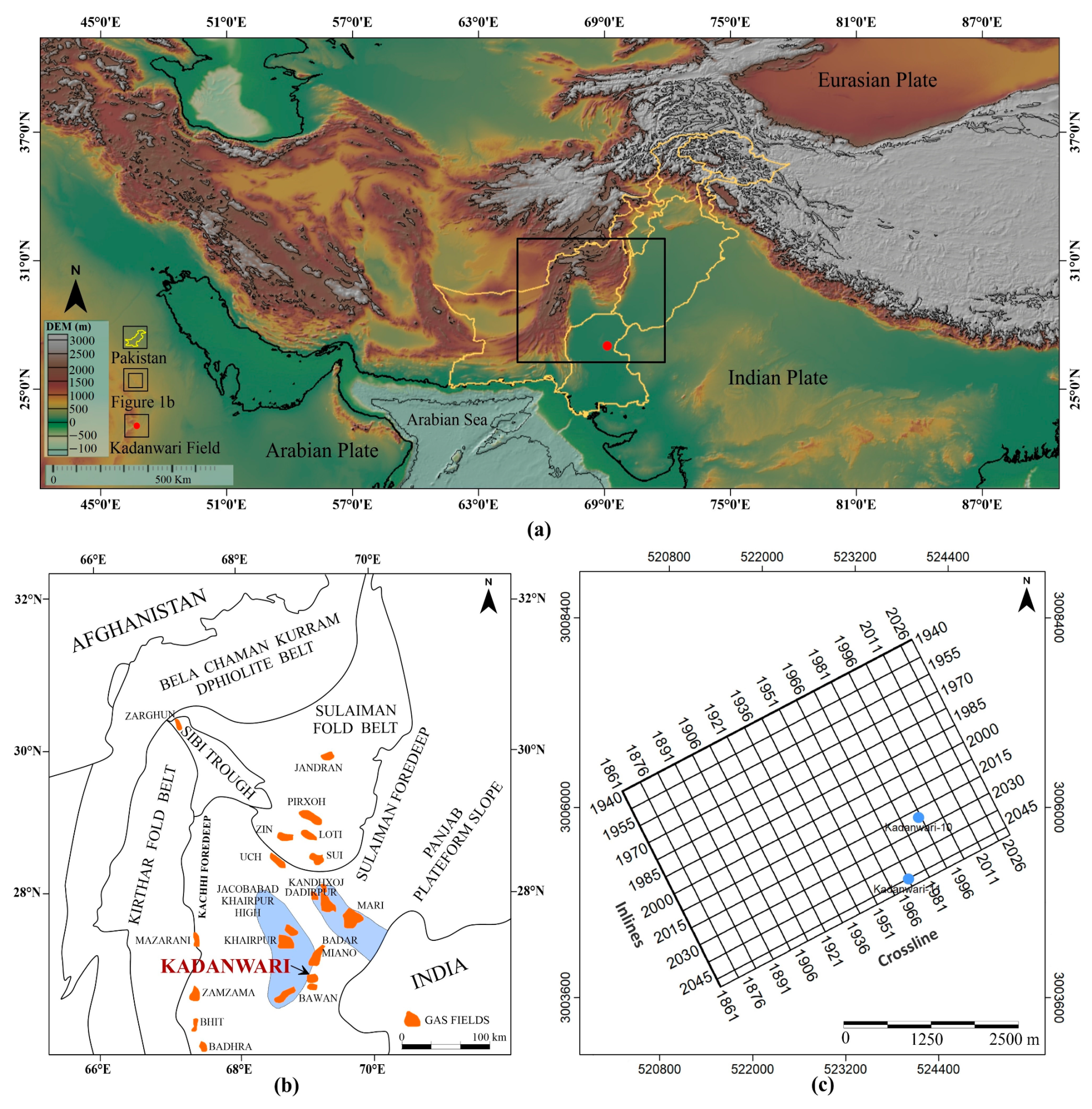
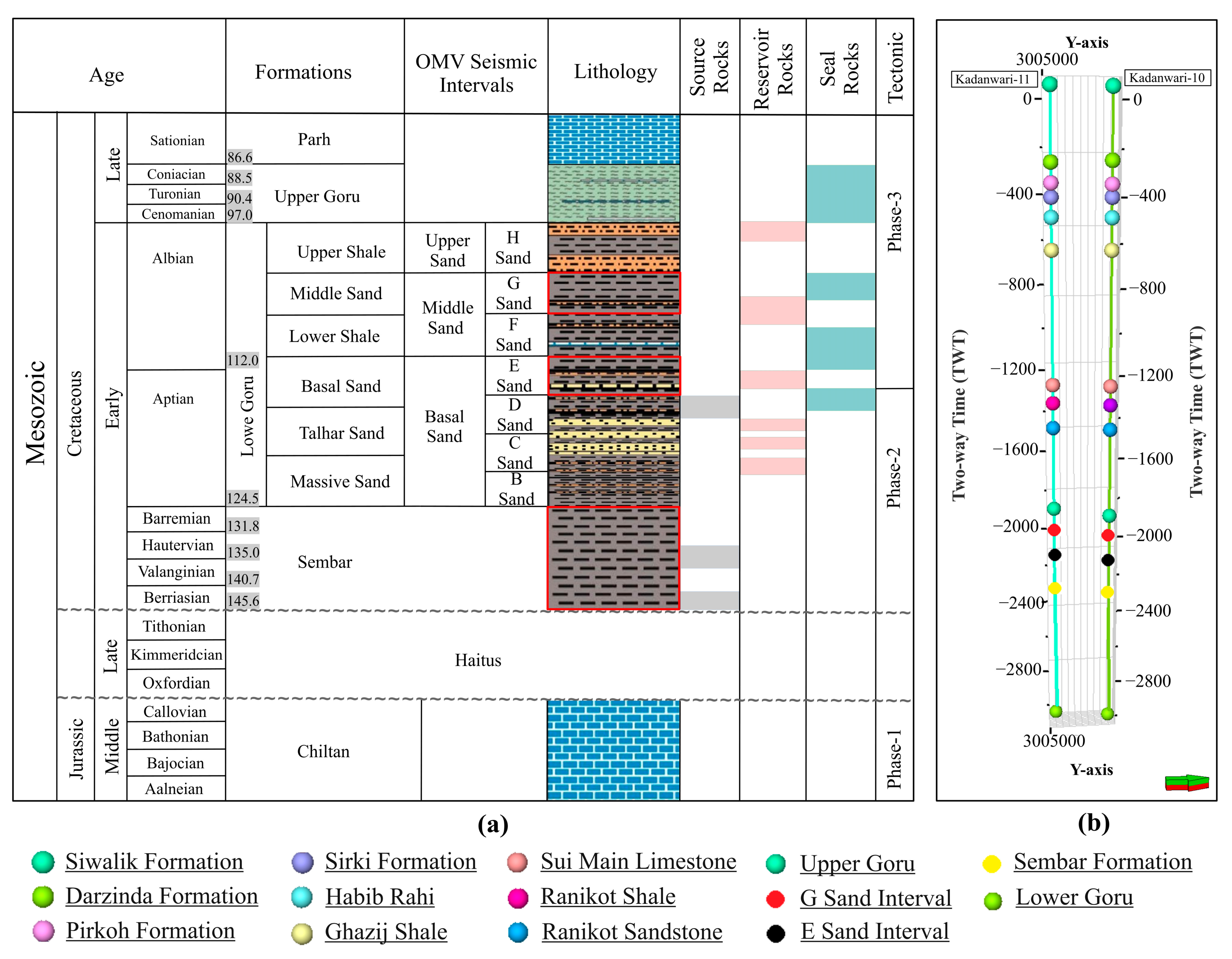
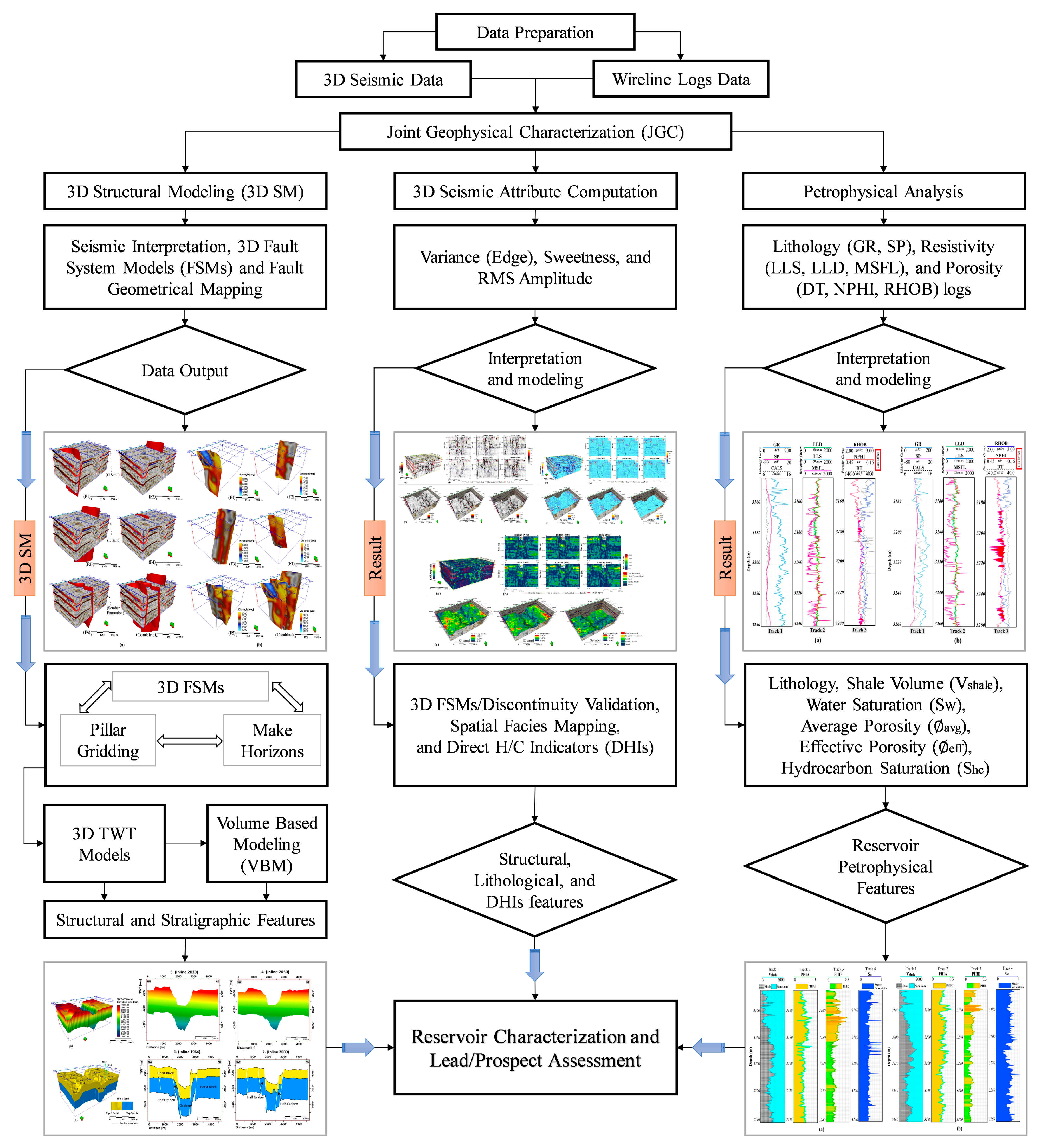

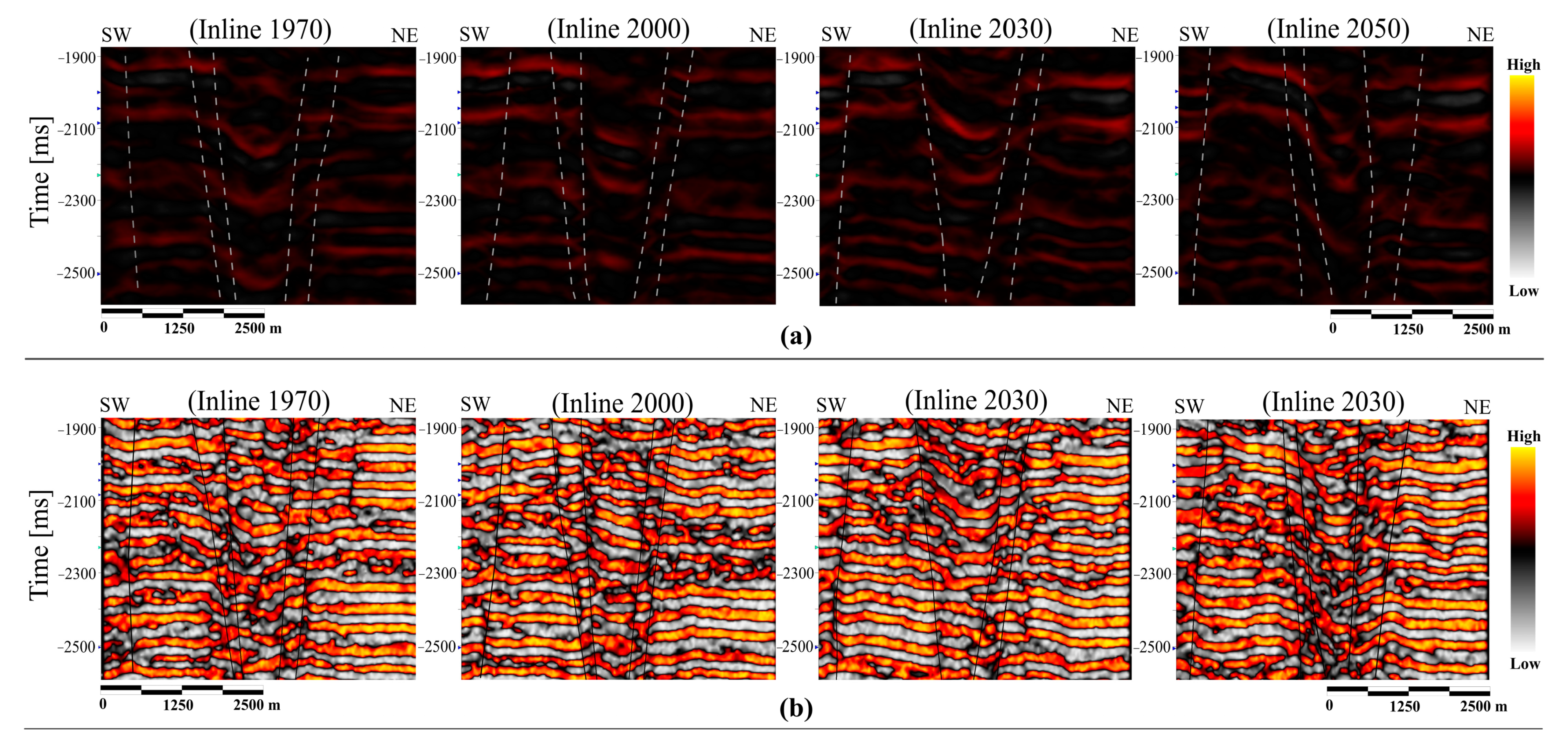


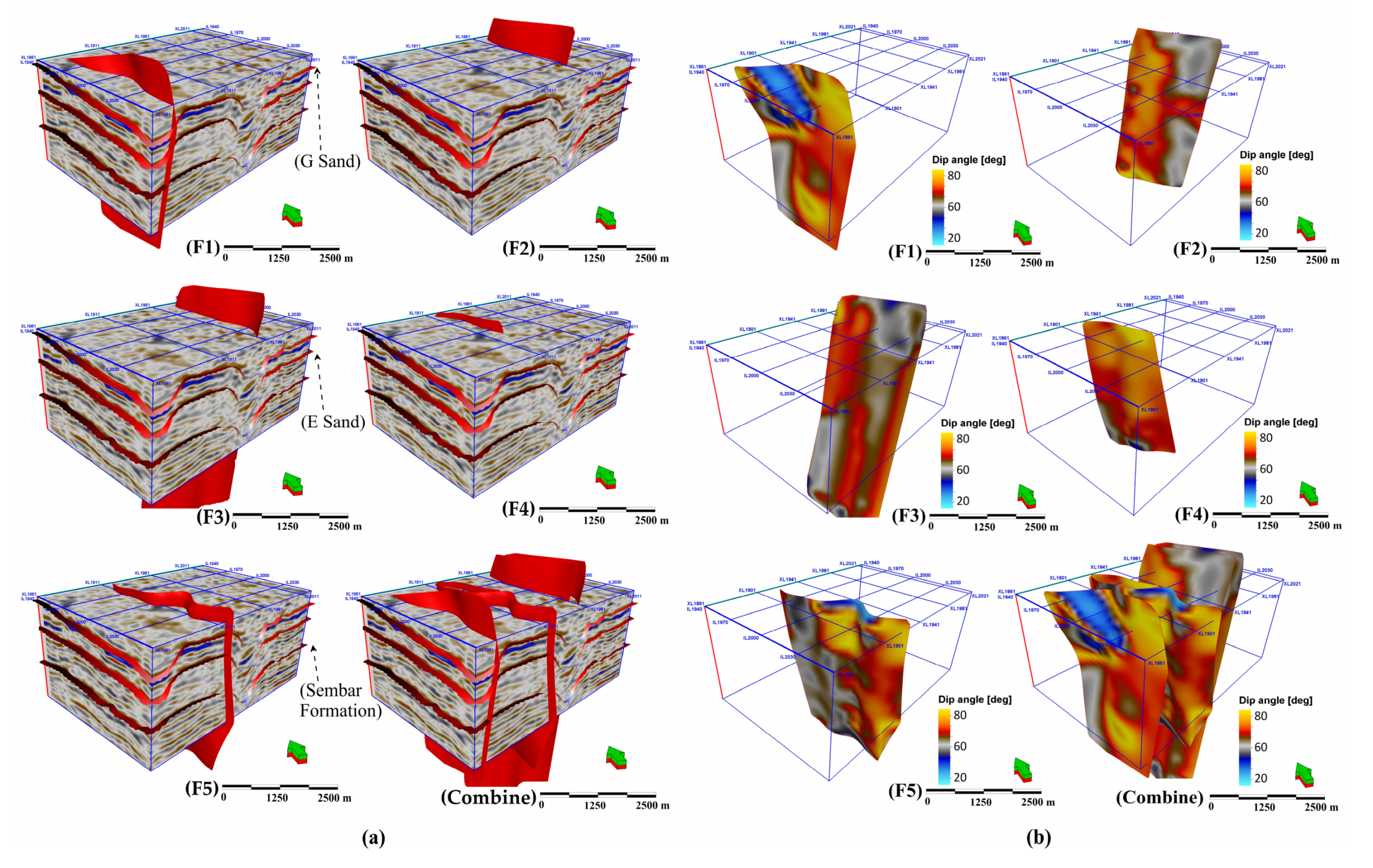
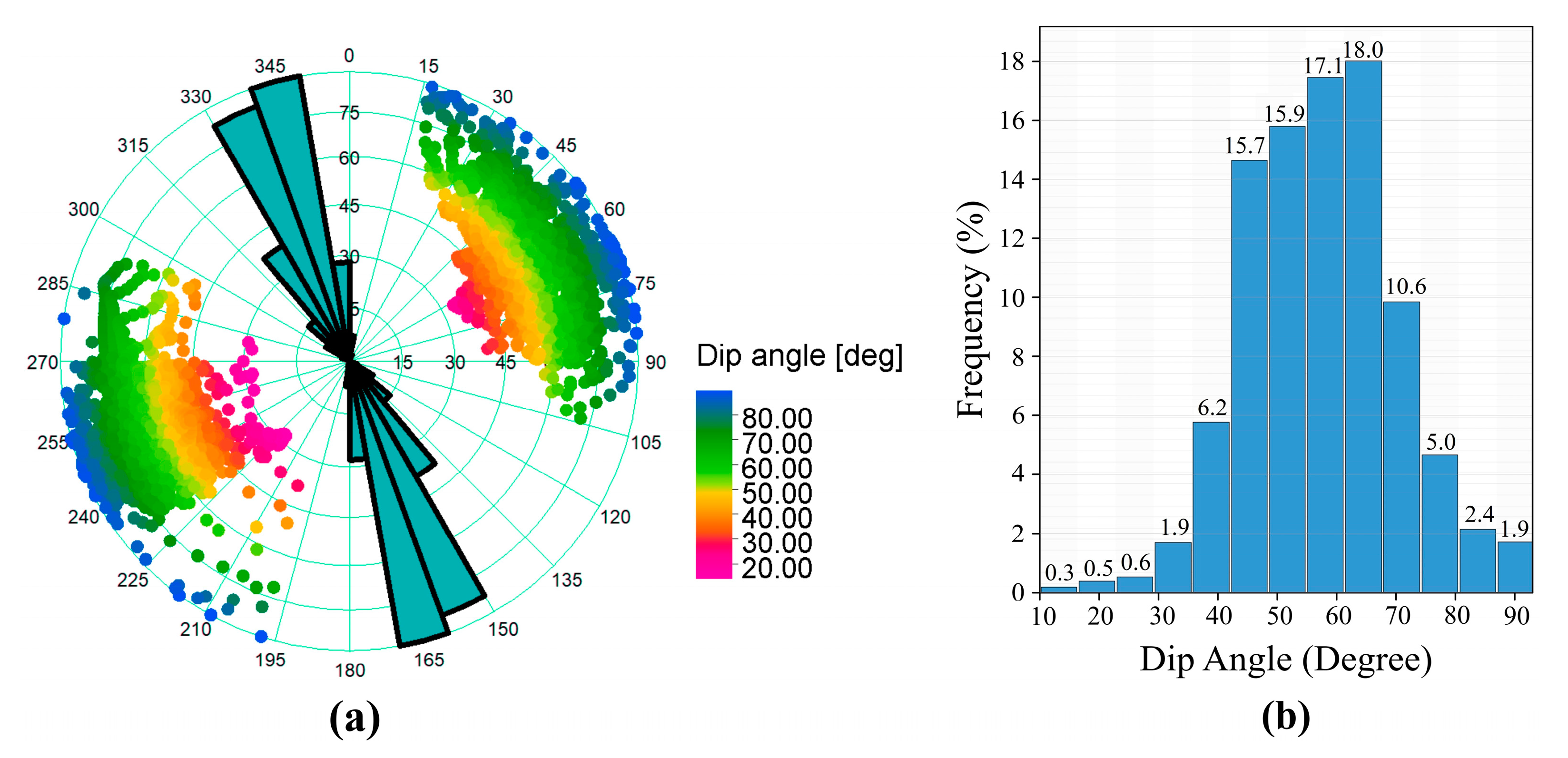
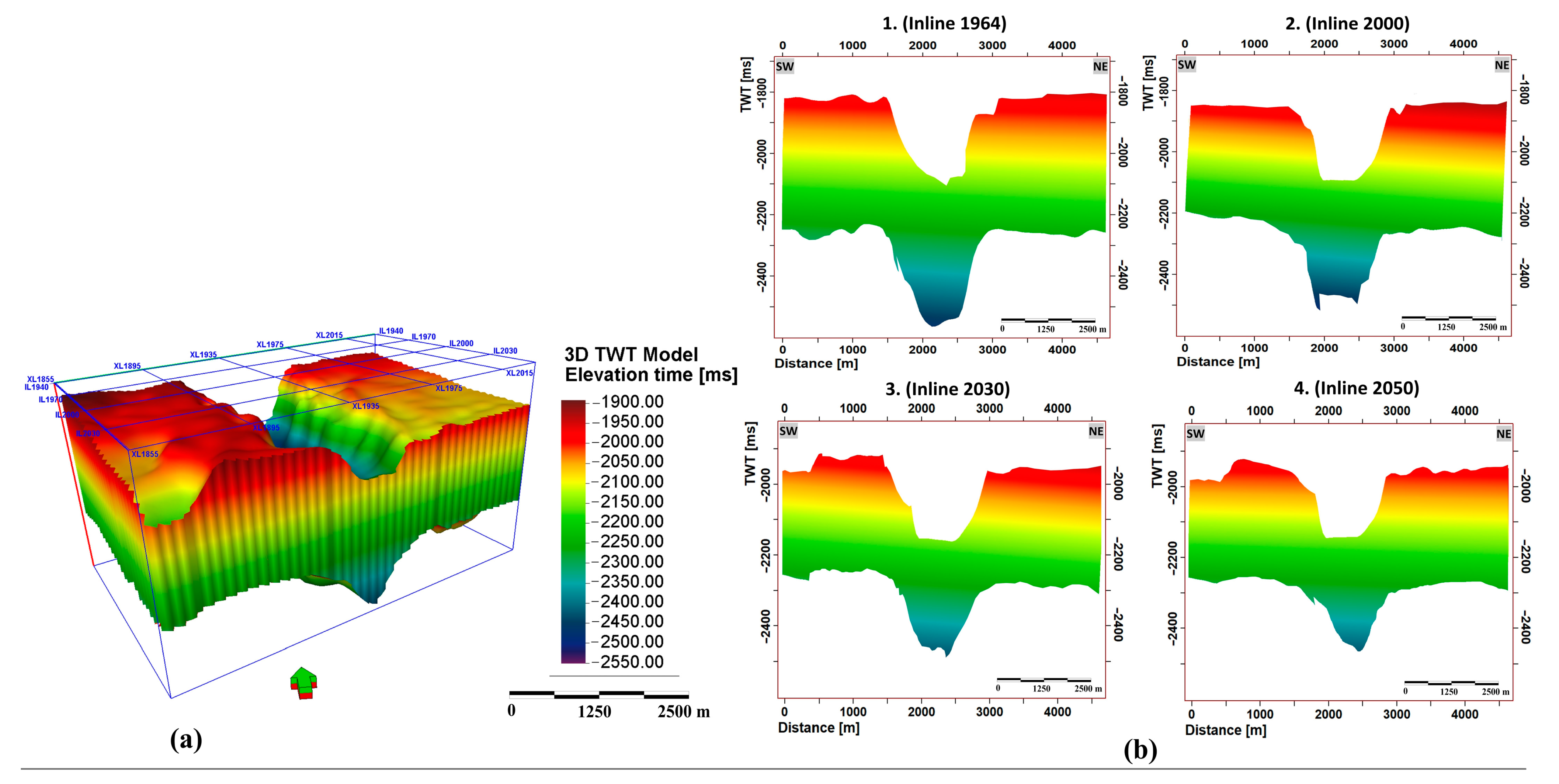
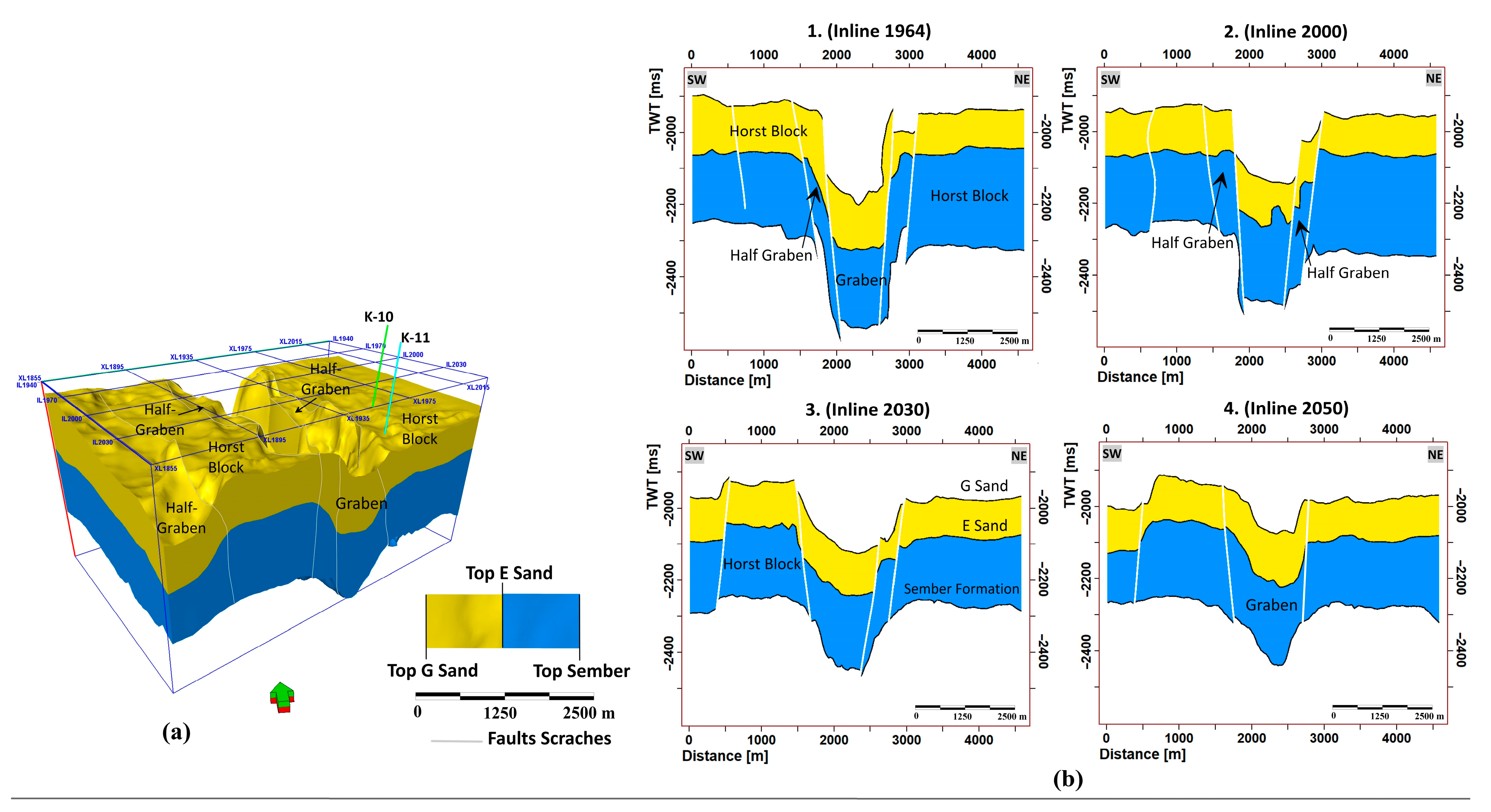
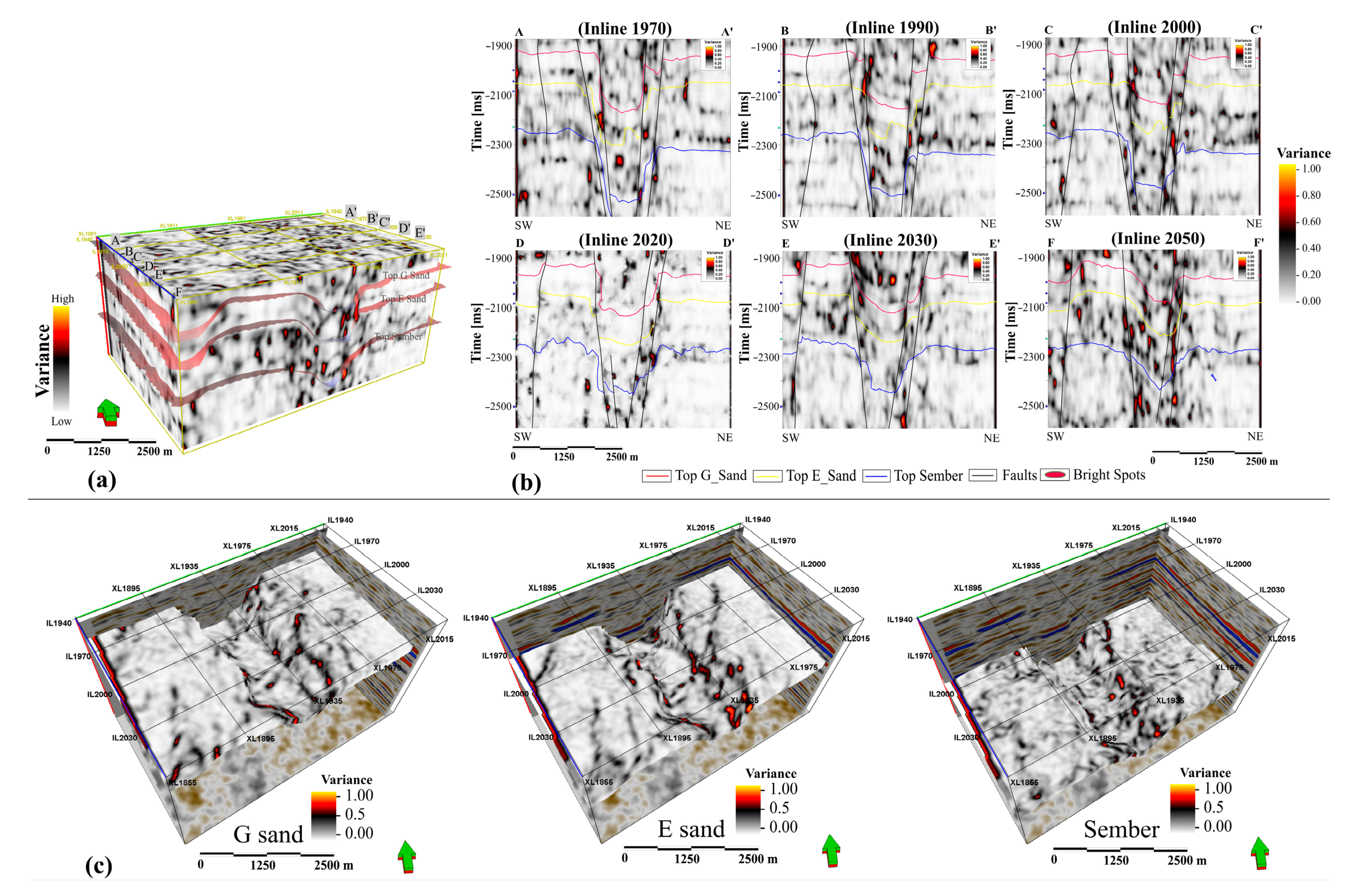
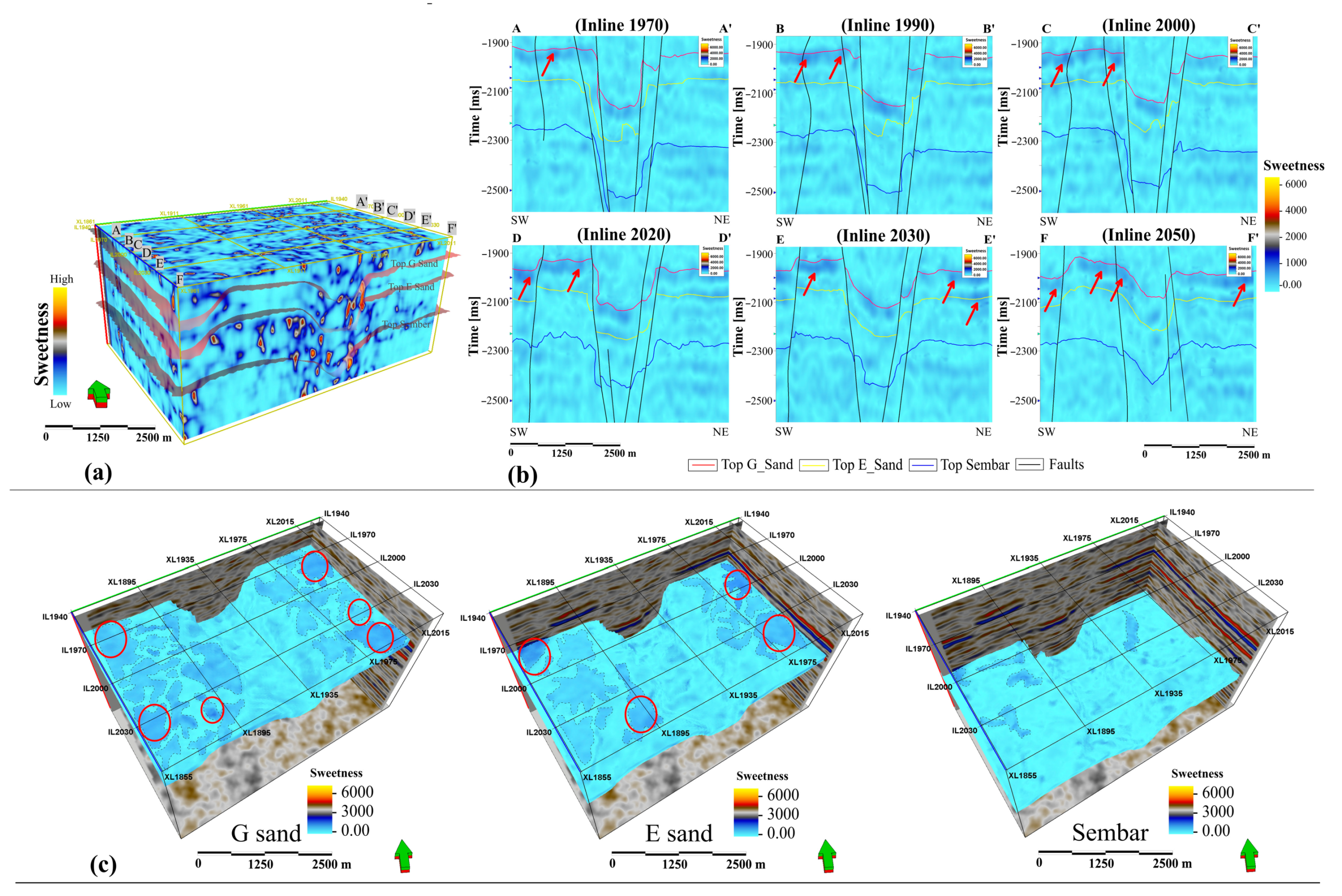
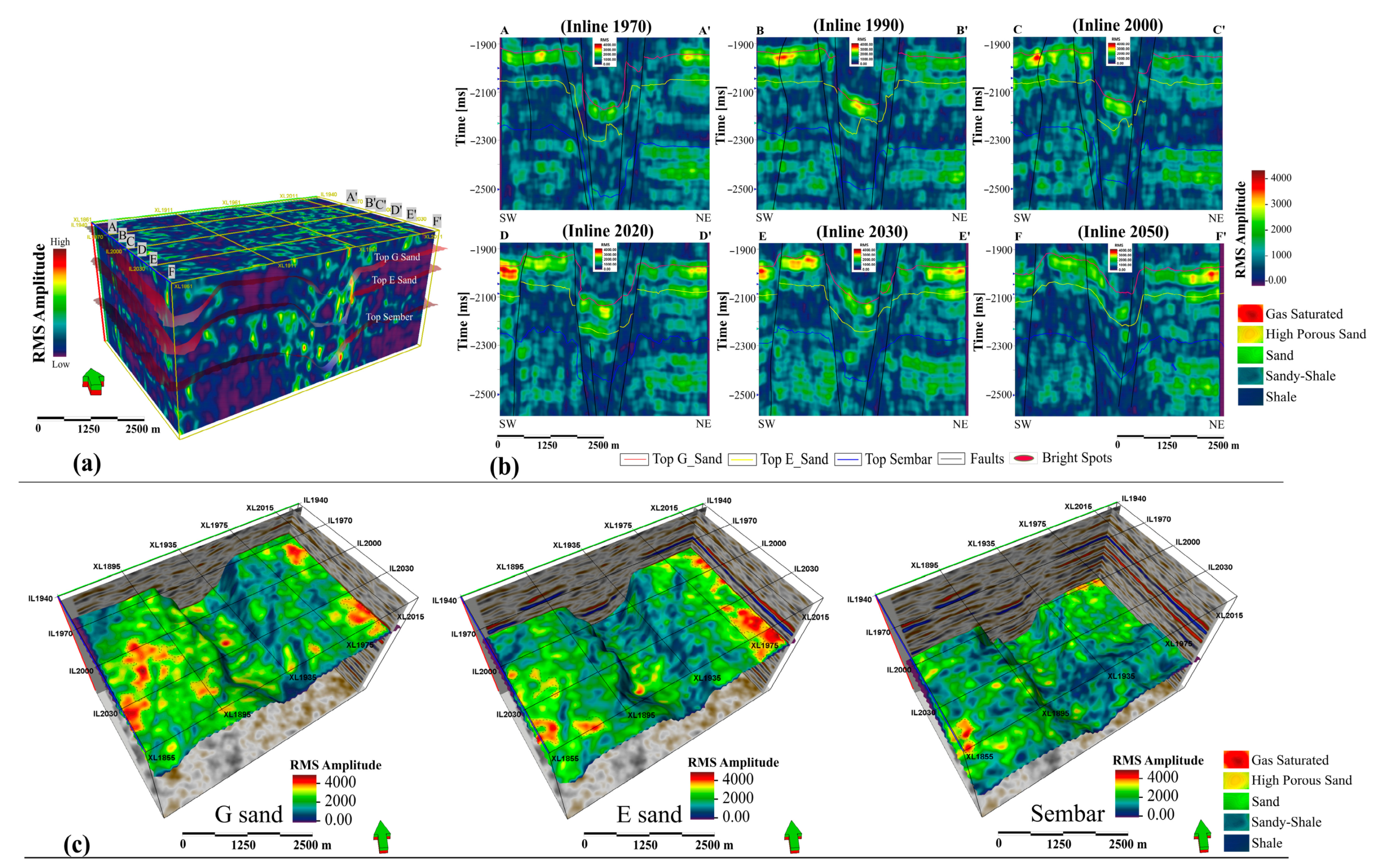
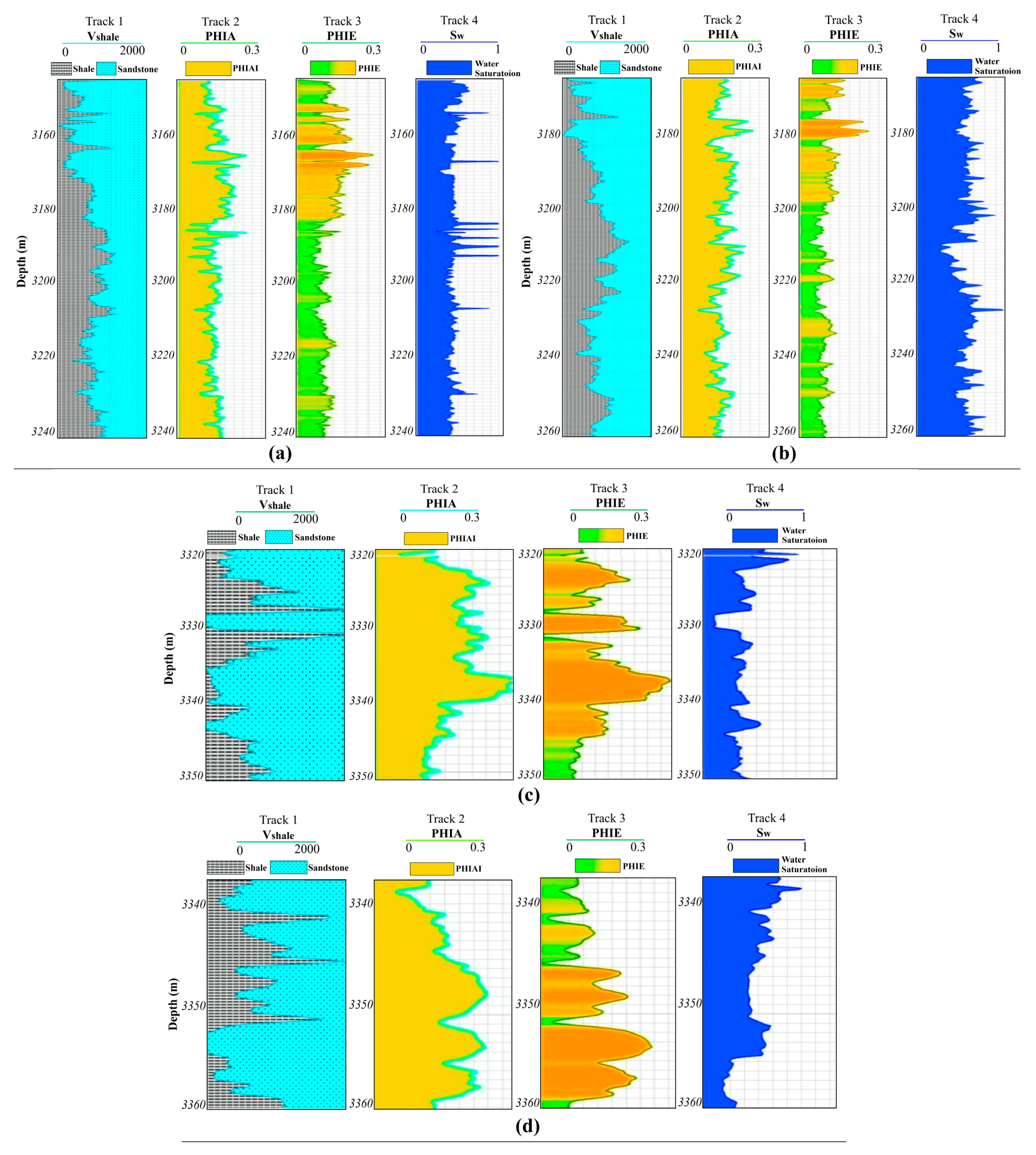
| Well Logs | Measured Property | Petrophysical Properties Estimated | Product |
|---|---|---|---|
| Caliper | Diameter | Borehole structure with depth | CALI |
| Gamma-ray | Radioactivity | Shale volume (Vshale) | GR |
| Laterolog deep | Resistance to electric current | Uninvaded resistivity | LLD |
| Laterolog shallow | Resistance to electric current | Invaded zone resistivity | LLS |
| Micro-spherical focused log | Resistance to electric current | Mud cake resistivity | MSFL |
| Sonic | Velocity of sound waves | Porosity | DT |
| Spontaneous Potential | Electric potential | Formation water resistivity | SP |
| Neutron | Hydrogen concentration | Porosity | NPHI |
| Density | Bulk density | Porosity | RHOB |
| Stratigraphic Interfaces | TWT Minimum | TWT Mean | TWT Maximum | Shallow Structure (TWT) | Deep Structure (TWT) |
|---|---|---|---|---|---|
| G sand interval | −1900 (ms) | −2037.5 (ms) | −2175 (ms) | −1900 to −2025 (ms) | −2026 to −2175 (ms) |
| E sand interval | −2025 (ms) | −2187.5 (ms) | −2350 (ms) | −2025 to −2100 (ms) | −2101 to −2350 (ms) |
| Sembar Formation | −2250 (ms) | −2400 (ms) | −2550 (ms) | −2250 to −2375 (ms) | −2376 to −2550 (ms) |
| Well No. | Intervals | Volume of Shale (Vshale) % | Effective Porosity (∅eff) % | Average Porosity (∅avg) % | Water Saturation (Sw) % |
|---|---|---|---|---|---|
| Kadanwari-10 | G sand interval | 36.11 | 7.8 | 12.2 | 45.4 |
| Kadanwari-11 | G sand interval | 36.11 | 8 | 12.56 | 45.4 |
| Well No. | Intervals | Volume of Shale (Vshale) % | Effective Porosity (∅eff) % | Average Porosity (∅avg) % | Water Saturation (Sw) % |
|---|---|---|---|---|---|
| Kadanwari-10 | E sand interval | 27.02 | 13.2 | 18.1 | 30.09 |
| Kadanwari-11 | E sand interval | 34.05 | 11.3 | 16.7 | 36.42 |
| Well No. | Intervals | Depth Range (m) | Thickness (m) | Hydrocarbon Saturation (Shc) % |
|---|---|---|---|---|
| Kadanwari-10 | G sand interval | 3145–3240 | 95 | 54.6 |
| E sand interval | 3320–3350 | 30 | 70.01 | |
| Kadanwari-11 | G sand interval | 3167–3260 | 93 | 55.02 |
| E sand interval | 3337–3360 | 23 | 63.58 |
| Fields | Original Recoverable | Cumulative Production | Balance Recoverable |
|---|---|---|---|
| Kadanwari | 1110 BCF | 420 BCF | 690 BCF |
| Miano | 552 BCF | 438 BCF | 114 BCF |
Publisher’s Note: MDPI stays neutral with regard to jurisdictional claims in published maps and institutional affiliations. |
© 2022 by the authors. Licensee MDPI, Basel, Switzerland. This article is an open access article distributed under the terms and conditions of the Creative Commons Attribution (CC BY) license (https://creativecommons.org/licenses/by/4.0/).
Share and Cite
Zhang, B.; Tong, Y.; Du, J.; Hussain, S.; Jiang, Z.; Ali, S.; Ali, I.; Khan, M.; Khan, U. Three-Dimensional Structural Modeling (3D SM) and Joint Geophysical Characterization (JGC) of Hydrocarbon Reservoir. Minerals 2022, 12, 363. https://doi.org/10.3390/min12030363
Zhang B, Tong Y, Du J, Hussain S, Jiang Z, Ali S, Ali I, Khan M, Khan U. Three-Dimensional Structural Modeling (3D SM) and Joint Geophysical Characterization (JGC) of Hydrocarbon Reservoir. Minerals. 2022; 12(3):363. https://doi.org/10.3390/min12030363
Chicago/Turabian StyleZhang, Baoyi, Yongqiang Tong, Jiangfeng Du, Shafqat Hussain, Zhengwen Jiang, Shahzad Ali, Ikram Ali, Majid Khan, and Umair Khan. 2022. "Three-Dimensional Structural Modeling (3D SM) and Joint Geophysical Characterization (JGC) of Hydrocarbon Reservoir" Minerals 12, no. 3: 363. https://doi.org/10.3390/min12030363







